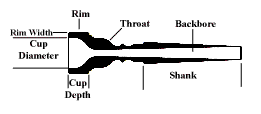



Well this is my attempt to explain some of the mysteries of mouthpieces. They are one of the easiest pieces of equipment to change, but what do they really do?


The first thing that is usually compared between mouthpieces is the cup diameter. It is a measurement of how wide the inside of the mouthpiece is. In general, bigger is better. It produces a darker, and more solid tone quality. Don't make the mistake of going too big though.The width and shape of the rim is one of the biggest factors in how the mouthpiece feels on your lips. A narrow rim will cut into the lips, and a round rim will not sit on the lips right. Most mouthpieces are right in the middle.
The throat, sometimes called the bore, is one of the big factors in how a mouthpiece plays. A large throat will give you a big sound, but it will be difficult to play soft. A small throat will give you more of an upper range, but it will not sound good, and the low range will severly be out of tune.
In general, a deeper cup is better. A deep cup will slightly lower the pitch of the instrument, and a shallow one will raise it, but just slightly. The theory is that a deeper cup will allow the lips to vibrate more fully. That is why Bach, and some other manufacturers have produced the Megatone. It is a REALLY deep cup.
The backbore allows for the biggest changes in the sound of a mouthpiece. It can change the volume, ease of possible by varying the shape, rate of taper, and size.
The last thing you can change on a mouthpiece is the shank. It is that that determines which horns you can use it on. Most tenor trombones are small shank. Bass trombones are large shank, as well as some tenors.

Materials
There are many materials available for mouthpieces. Most common is silver plated brass Gold plating is also available. Gold feels better on the face. But it is also more slippery. My mouthpiece is plated gold on the rim and inside. I didn't notice a difference at first, but now I love it.Plastic rims are available for two reasons. First is that some people are alergic to gold and silver, and this is the best option. I know that there are several types of plastic available from Doug Elliot, each offers different qualities. The second reason is that if you were playing at a cold football game or a parade, if you had a plastic rim, your lips wouldn't get stuck to the mouthpiece. I haven't tried them, but I hear that they do not sound as good as metal mouthpieces.
I once saw a set of wooden mouthpieces in a display case at Rayburn Music, in Boston. All I know about them is that they were expensive.